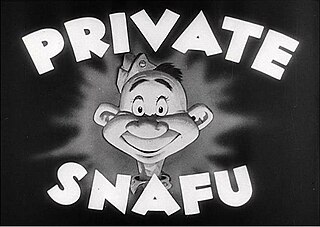
SNAFU is an acronym that is widely used to stand for the sarcastic expression Situation normal: all fucked up. It is a well-known example of military acronym slang. It is sometimes censored to "all fouled up" or similar. It means that the situation is bad, but that this is a normal state of affairs. The acronym is believed to have originated in the United States Marine Corps during World War II.
Military slang is an array of colloquial terminology used commonly by military personnel, including slang which is unique to or originates with the armed forces. In English-speaking countries, it often takes the form of abbreviations/acronyms or derivations of the NATO Phonetic Alphabet, or otherwise incorporates aspects of formal military terms and concepts. Military slang is often used to reinforce or reflect interservice rivalries.

Private Snafu is the title character of a series of black-and-white American instructional adult animated shorts, ironic and humorous in tone, that were produced between 1943 and 1945 during World War II. The films were designed to instruct service personnel about security, proper sanitation habits, booby traps and other military subjects, and to improve troop morale. Primarily, they demonstrate the negative consequences of doing things wrong. The main character's name is a play on the military slang acronym SNAFU, "Situation Normal: All Fucked Up".

In military slang, a spider hole is a type of camouflaged one-man foxhole, similar to a surveillance/hidesite used for observation.

COBRA is a fictional terrorist organization and the nemesis of the G.I. Joe Team in the Hasbro action figure toyline G.I. Joe: A Real American Hero and G.I. Joe: Sigma 6, as well as in related media.

Cobra Commander is a fictional character and the main antagonist of the G.I. Joe: A Real American Hero franchise. He is the supreme leader of the terrorist organization Cobra and the archenemy of the G.I. Joe Team. He was portrayed by Joseph Gordon-Levitt in the film G.I. Joe: The Rise of Cobra, and by Luke Bracey with the voice of Robert Baker in the 2013 sequel G.I. Joe: Retaliation.

The South African Defence Force (SADF) comprised the armed forces of South Africa from 1957 until 1994. Shortly before the state reconstituted itself as a republic in 1961, the former Union Defence Force was officially succeeded by the SADF, which was established by the Defence Act of 1957. The SADF, in turn, was superseded by the South African National Defence Force in 1994.
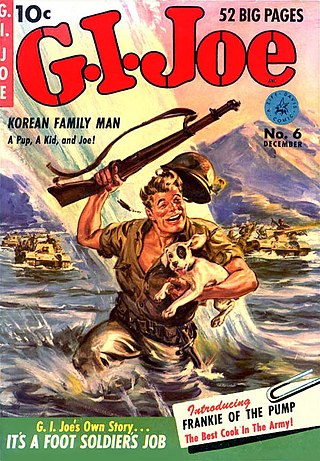
G.I. Joe has been the title of comic strips and comic books in every decade since 1942. As a licensed property by Hasbro, G.I. Joe comics have been released from 1967 to present, with only two interruptions longer than a year. As a team fighting Cobra since 1982, the comic book history of G.I. Joe: A Real American Hero has been covered by three separate publishers and four main-title series, all of which have been based on the Hasbro toy line of the same name.
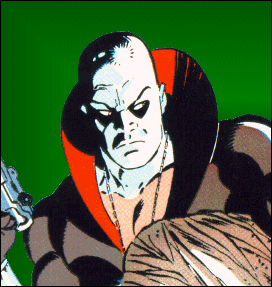
Laird James McCullen Destro XXIV, usually referred to simply as Destro, is a fictional character from the G.I. Joe: A Real American Hero toyline, comic books, and cartoon series. He is the Scottish leader of the Iron Grenadiers, and founder of M.A.R.S. Industries, a weapons manufacturer, and supplier for Cobra. Destro is portrayed by Christopher Eccleston in the 2009 live-action film G.I. Joe: The Rise of Cobra, and by an uncredited extra in its 2012 sequel G.I. Joe: Retaliation.

Flint is a fictional character from the G.I. Joe: A Real American Hero series. He was originally created as a character for the Sunbow G.I. Joe animated series in 1984, and later introduced into the comic book and produced as an action figure in 1985. He is portrayed by D.J. Cotrona in the 2013 film G.I. Joe: Retaliation.

Military camouflage is the use of camouflage by an armed force to protect personnel and equipment from observation by enemy forces. In practice, this means applying colour and materials to military equipment of all kinds, including vehicles, ships, aircraft, gun positions and battledress, either to conceal it from observation (crypsis), or to make it appear as something else (mimicry). The French slang word camouflage came into common English usage during World War I when the concept of visual deception developed into an essential part of modern military tactics. In that war, long-range artillery and observation from the air combined to expand the field of fire, and camouflage was widely used to decrease the danger of being targeted or enable surprise. As such, military camouflage is a form of military deception in addition to cultural functions such as political identification.
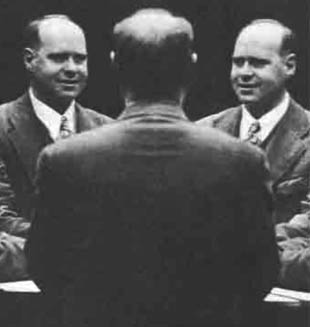
Irving David Breger was an American cartoonist who created the syndicated Mister Breger (1945–1970), a gag panel series and Sunday comic strip known earlier as Private Breger and G.I. Joe. The series led to widespread usage of the term "G.I. Joe" during World War II and later. Dave Breger was his signature and the byline on his books. During World War II, his cartoons were signed Sgt. Dave Breger.

G.I. Joe is the code name of a fictional elite covert special operations unit operating under the control of the United States Armed Forces in the G.I. Joe universe. In the 1960s and 1970s, a toy military adventure character based on General Joseph Colton was available. From 1982, the name "G.I. Joe" referred to the team, also known as the "Joe team" or the "Joes". The G.I. Joe team was introduced as the G.I. Joe: A Real American Hero toyline by Hasbro. Later, the Marvel G.I. Joe: A Real American Hero comic books and the G.I. Joe: A Real American Hero television cartoons were released. The team's battle cry is "Yo Joe!"
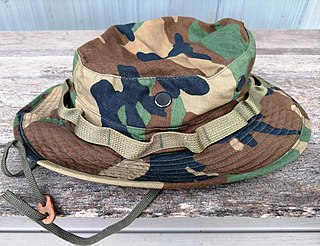
A boonie hat or booney hat is a type of wide-brim sun hat commonly used by military forces in hot tropical climates. Its design is similar to a bucket hat but with a stiffer brim.

The Afghanka is a type of military uniform system developed and issued by the Soviet Army in the early 1980s, still in use today in some post-Soviet states in many different variants. The name Afghanka is an unofficial popular slang term in Russian for the uniform, derived from its prolific use during the Soviet–Afghan War.

Short-Fuze is a fictional character from the G.I. Joe: A Real American Hero toyline, comic books and animated series. He is the G.I. Joe Team's original mortar soldier and debuted in 1982.

Wild Bill is a fictional character from the G.I. Joe: A Real American Hero toyline, comic books and animated series. He is the G.I. Joe Team's helicopter pilot and debuted in 1983.
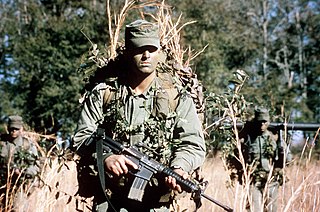
A patrol hat, also known as a field cap or soft cap, is a soft kepi constructed similarly to a baseball cap, with a stiff, rounded visor but featuring a flat top, worn by military personnel of some countries in the field when a combat helmet is not required.


















